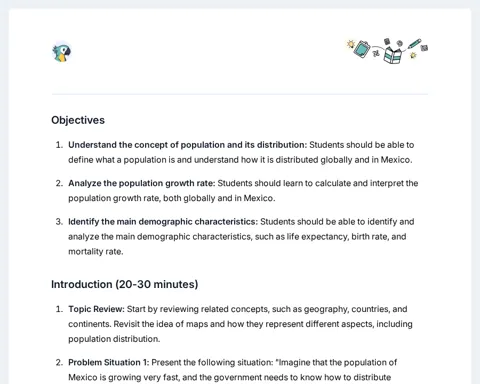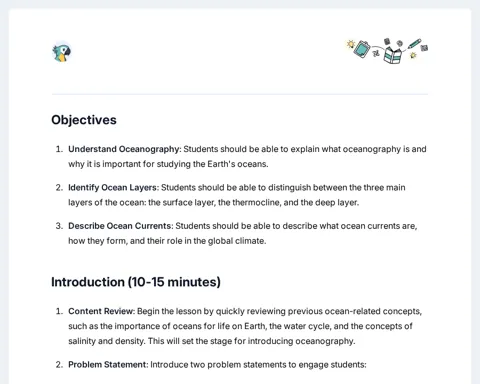Objectives
-
Understand the Formation of Volcanoes: Students will learn how volcanoes are formed, including the role of tectonic plates, magma, and pressure.
-
Identify Different Types of Volcanoes: Students will be able to distinguish between the three main types of volcanoes: shield, composite, and cinder cone, and understand the characteristics of each.
-
Explore the Impacts of Volcanic Eruptions: Students will examine the effects of volcanic eruptions on the surrounding environment and human lives, including both natural and economic impacts.
Introduction (10-15 minutes)
-
Review of Previous Concepts: Begin the lesson by briefly reviewing the concepts of plate tectonics and Earth’s interior, as these will be crucial to understanding volcano formation. You can use a diagram of the Earth's layers and tectonic plates to aid comprehension.
-
Problem-Solving Scenarios:
- First scenario: "Imagine you are a scientist studying an active volcano. How would you explain to the local community how a volcano forms and how it can erupt?"
- Second scenario: "Suppose you are an emergency response manager. What would you need to consider when preparing for a possible volcanic eruption in your area?"
-
Contextualization: Explain the relevance of studying volcanoes. Discuss how volcanic eruptions can affect the environment, climate, and human lives, citing recent examples of eruptions and their impacts.
-
Engaging Students’ Attention:
- Curiosity 1: "Did you know that the largest volcano in the solar system is on Mars? It's called Olympus Mons, and it's over 13 miles high!"
- Curiosity 2: "What if I told you that volcanoes can actually create new land? When lava cools, it solidifies and forms new rock, which can eventually become land."
-
Introduction to the Topic: Introduce the topic of volcanoes, explaining that they are openings in the Earth's crust through which magma, ash, and gases erupt. Mention that today, students will learn about how volcanoes are formed, the different types of volcanoes, and the impacts of eruptions.
Development (20-25 minutes)
-
Activity 1 – Volcano Model Creation (10-15 minutes)
-
Materials Needed: Modeling clay, straws, cardboard, colored paper, tape, markers.
-
Activity Description: Divide the class into groups of 4-5 students. Each group will create a model of a volcano using the provided materials. They should base the model on one of the three types of volcanoes: shield, composite, or cinder cone. The model should have an opening at the top where magma (represented by colored paper) can "erupt."
-
Step-by-Step:
- Research: Students should begin by researching the assigned type of volcano. They need to understand the specific characteristics of their volcano type, such as shape, size, and eruption style.
- Planning: After the research, students should plan how they will build the volcano model. They should consider what materials they will use and how they will represent the magma.
- Construction: Students should then start building the volcano model. They should pay attention to detail and ensure that the model accurately represents the assigned volcano type.
- Presentation: Finally, each group should present their volcano model to the class, explaining the characteristics of their volcano type and how it relates to volcano formation.
-
-
Activity 2 – Simulating a Volcanic Eruption (10-15 minutes)
-
Materials Needed: Baking soda, vinegar, food coloring, small cups, trays.
-
Activity Description: Still in their groups, students will simulate a volcanic eruption using the volcano models they created in the previous activity. The eruption will be represented by a chemical reaction between baking soda and vinegar, which will produce a gas (carbon dioxide) that will "erupt" from the volcano.
-
Step-by-Step:
- Preparation: Students should place the volcano model on a tray to catch any spills. They should fill the opening of the volcano with a mixture of baking soda and food coloring.
- Simulating the Eruption: Then, students should pour vinegar into the volcano opening. The vinegar will react with the baking soda, producing carbon dioxide gas, which will "erupt" from the volcano.
- Observation and Discussion: Students should observe the eruption and discuss what is happening. They should relate the eruption to what they learned about volcanoes. For example, they can discuss how the reaction between baking soda and vinegar represents the eruption of magma from a volcano.
-
Return (10-15 minutes)
-
Group Discussion (5-7 minutes)
- Gather the whole class and have each group share their volcano models and the eruption simulation results. Each group should explain the type of volcano they represented and how the eruption simulation relates to real volcanic eruptions.
- Encourage students to ask questions and make comments about the models and simulations presented by other groups. This will promote interaction and further understanding of the topic.
-
Connection to Theory (3-5 minutes)
- After the presentations, facilitate a discussion on how the activities connect to the theory presented at the beginning of the lesson. Ask students to explain how their volcano models and the eruption simulation reflect the formation and functioning of real volcanoes.
- Reinforce the key concepts, highlighting the importance of understanding volcano formation and the different types of volcanoes to comprehend volcanic eruptions.
-
Individual Reflection (2-3 minutes)
- To wrap up the lesson, have students individually reflect on what they learned. Ask them to write down one question they still have about volcanoes and one concept they found most interesting.
- Emphasize that these reflections are not for grading but for students to consolidate their learning and identify any areas that need further clarification.
-
Teacher Feedback (1-2 minutes)
- Finally, provide overall feedback on the lesson. Praise the students' effort and participation and highlight what was done well. Also, mention any areas that may need improvement or that will be revisited in future lessons.
- Encourage students to continue exploring the topic and to bring their questions to the next lesson.
Conclusion (5-7 minutes)
-
Summary and Recapitulation (2-3 minutes)
- Begin the Conclusion by summarizing the key points of the lesson. Recap how volcanoes are formed, the different types of volcanoes, and the impacts of volcanic eruptions on the environment and human lives.
- Emphasize the connections between theory and the practical activities carried out, highlighting how the volcano models and the eruption simulation helped illustrate the concepts discussed.
-
Theory and Practice Connection (1-2 minutes)
- Explain how the lesson combined theory and practice. The theoretical part provided the knowledge necessary to understand volcanoes, while the practical activities allowed students to apply this knowledge in a hands-on way.
- Highlight the importance of understanding volcanoes, not just as a theoretical concept but as a real phenomenon that has significant impacts on our planet.
-
Extra Materials (1-2 minutes)
- Suggest extra materials for students who wish to deepen their understanding of volcanoes. This could include documentaries, interactive websites, educational games, and books on the subject.
- Some examples of materials could be:
- Documentary: "Into the Volcano"
- Website: "National Geographic Kids - Volcanoes"
- Educational Game: "Volcano Island"
-
Topic Relevance (1 minute)
- Finally, explain the relevance of studying volcanoes. Discuss how understanding volcanoes can help us predict and prepare for volcanic eruptions, which can save lives and minimize economic losses.
- Also, mention how studying volcanoes can help us better understand the geology and evolution of our planet.




